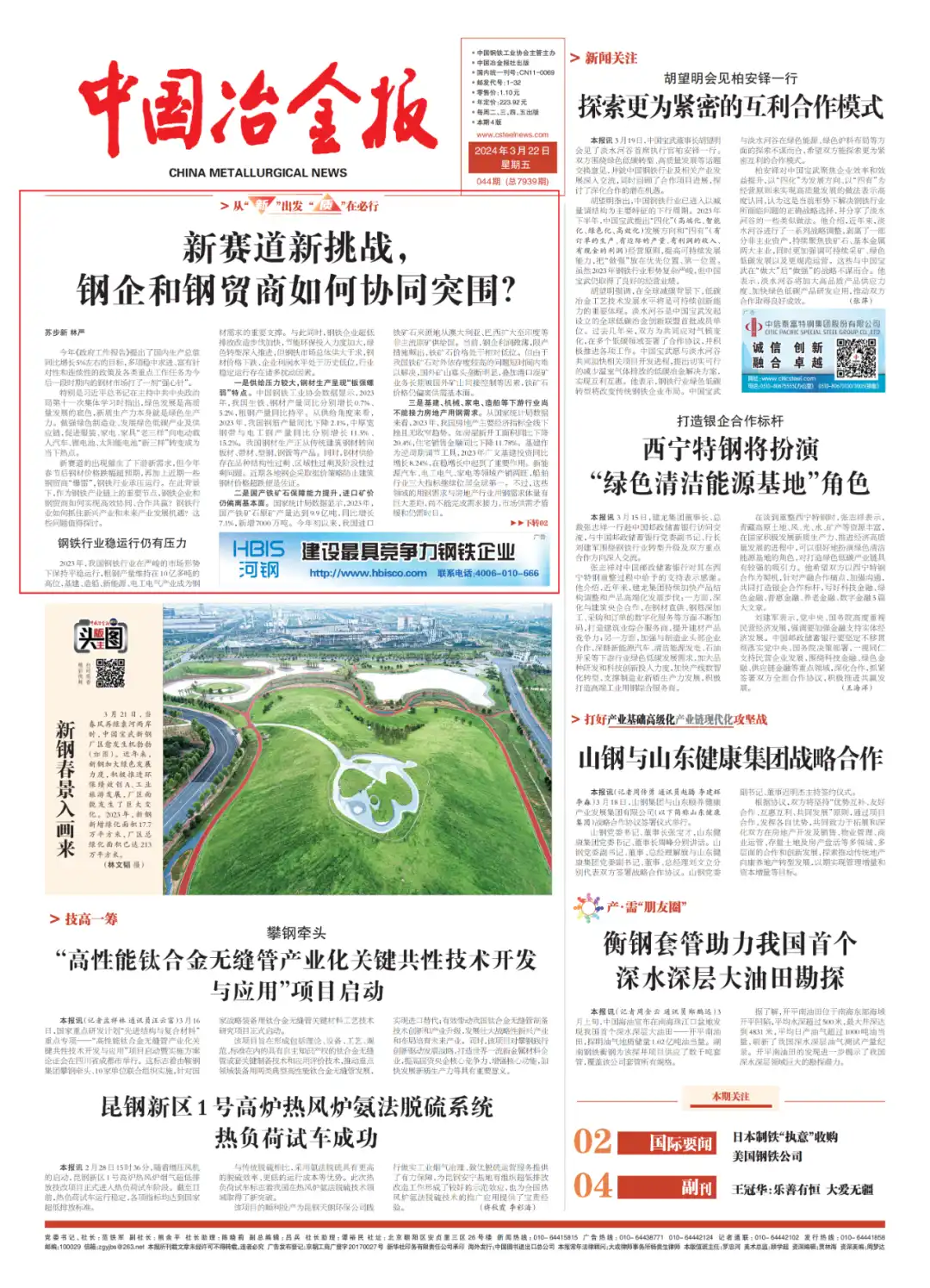New engine of steel market:Emerging industries unleash growth potential
This year's "Government Work Report" puts forward the goal of GDP growth of about 5% year-on-year. A number of policies and various key tasks that seek progress while maintaining stability, are targeted and continuous, and will provide a "boost in the arm" for the steel market in the future.
In particular, General Secretary Xi Jinping pointed out when presiding over the 11th collective study session of the Political Bureau of the CPC Central Committee that green development is the background of high-quality development, and new productivity itself is green productivity. Strengthen green manufacturing, develop green and low-carbon industries and supply chains, and promote the transformation of the "three old things" of clothing, home appliances, and furniture into the "three new things" of electric passenger vehicles, lithium batteries, and solar cells to become current hot spots.
The emergence of new tracks has given rise to new downstream demand, but steel prices fell more than expected after the Spring Festival this year. Coupled with the recent "explosions" of some steel traders, the steel industry is under pressure. In this context, as important nodes in the steel industry chain, how can steel companies and steel traders achieve efficient collaboration and win-win cooperation? How can the steel industry seize opportunities for emerging industries and future industrial development? These issues are worth exploring.
01 [There is still pressure on the stable operation of the steel industry]
In 2023, China's steel industry will maintain stable operation under severe market conditions, with crude steel output remaining at a high level of more than 1 billion tons. Infrastructure, shipbuilding, new energy, and electrical and electrical industries will become important supports for steel demand. At the same time, the pace of ultra-low emission transformation of steel companies has accelerated, investment in energy conservation and environmental protection has increased, and green transformation has been further advanced. However, the overall supply in the steel market has exceeded demand, steel prices have fallen, corporate profit levels are at historical lows, and there are many disturbances in the stable operation of the industry. factor.
First, the supply pressure is high, and steel production is characterized by "strong plates and weak screws". 中国钢铁工业协会数据显示,2023年,中国生铁、钢材产量同比分别增长0.7%、5.2%,粗钢产量同比持平。从供给角度来看,2023年,中国钢筋产量同比下降2.1%,中厚宽钢带与电工钢产量同比分别增长11.5%、15.2%。中国钢材生产正从传统建筑钢材转向板材、带材、型钢、钢管等产品。同时,钢材供给存在品种结构性过剩、区域性过剩及阶段性过剩问题。近期各地钢企采取挺价策略防止建筑钢材价格超跌便是佐证。
Second, China's ability to ensure iron ore manufacturing has improved, and imported ore prices still deviate from fundamentals. 国家统计局数据显示,2023年,中国制造铁矿石原矿产量达到9.9亿吨,同比增长7.1%,新增7000万吨。今年初以来,中国进口铁矿石来源地从澳大利亚、巴西扩大至印度等非主流原矿供给国。当前,钢企利润微薄,限产措施频出,铁矿石价格处于相对低位。但由于中国铁矿石对外依存度较高的问题短时间内难以解决,国外矿山寡头垄断明显,叠加港口混矿业务长期被国外矿山间接控制等因素,铁矿石价格仍偏离供需基本面。
Third, downstream industries such as infrastructure, machinery, home appliances, and shipbuilding cannot yet rely on the demand for real estate steel. 从国家统计局数据来看,2023年,中国房地产主要经济指标全线下挫且无收窄趋势。如房屋新开工面积同比下降20.4%,住宅销售金额同比下降11.78%。基建作为逆周期调节工具,2023年广义基建投资同比增长8.24%,在稳增长中起到了重要作用。新能源汽车、电工电气、家电等领域产销两旺,船舶行业三大指标继续位居全球第一。不过,这些领域的用钢需求与房地产行业用钢需求体量有巨大差距,尚不能完成需求接力,市场供需矛盾缓和仍需时日。
Fourth, companies are facing increasingly severe pressure from environmental protection and production restrictions. 当前,中国钢铁行业正在探索具有环境、能效、碳排放政策约束的产能治理新机制。具体来看,一是部分工业大省要完成中央下达的能耗双控考核任务,今年钢铁产量调控政策大概率将延续。二是目前钢铁行业超低排放进程尚未过半,流程间、地域间发展不均衡,企业在上马超低排放改造项目时势必要增加吨钢投资及电能消耗,运营成本压力明显。三是当前钢铁行业极致能效工程已形成三套清单、两套标准及相应数据治理模式,但中国钢铁企业各项能效提升的空间越来越小,未来采用何种方式完成能效约束目标任务值得关注。
02 [New track brings new growth points for demand]
With the accelerated layout of emerging and future industries and the accelerated transformation and upgrading of traditional industries, the new track has brought new opportunities to the steel industry and new growth points in steel demand.
First, building materials are developing in the direction of high-performance. 国家统计局数据显示,2023年,中国城镇化率为66.16%,9个省级行政区城镇化率超过70%,城镇化进程放缓。人口总量连续两年负增长,总和生育率处在极低区间。建筑行业转型发展箭在弦上,建筑材料将从结构性材料向功能性材料转变。其中,装配式钢结构建筑由于抗震性能好、施工周期短、便于运输、绿色环保等优势脱颖而出,成为行业大力倡导的绿色建筑发展趋势,预计相应的型钢需求将增多。
Second, new infrastructure brings considerable development space. 新基建领域,按照用钢强度排序,依次为城际高速铁路和城际轨道交通、特高压、新能源汽车充电桩、5G基站、大数据中心、工业互联网及人工智能,预计今年新基建将消耗钢材约3300万吨。其中,用于特高压的高牌号取向硅钢,以及用于轨道交通的耐候钢、重轨钢、不锈钢、车轮车轴用钢等需求较为可观,传统建筑用钢需求也将获得一定支撑。
The third is the replacement of equipment and the replacement of old consumer goods with new ones. 3月7日,国务院印发《推动大规模设备更新和消费品以旧换新行动方案》,聚焦设备更新、消费品以旧换新、回收循环利用、标准提升四大行动。据乘用车市场信息联席会预测,到2027年,中国汽车年均报废回收量有望达到1500万辆,二手车交易量同比2023年将增长45%。未来,随着电机能效水平逐渐提升,汽车行业电气化转型加速,旧城区改造等深入推进,型钢、汽车板、高牌号无取向硅钢等产品消费预期将向好。
Fourth, steel for offshore engineering has a wide range of application scenarios. 当前,中国汽车运输船用钢、散货船和油船用钢需求持续增长。中国船舶工业行业协会数据显示,2023年,全国造船新承接订单量达到7120万载重吨,同比增长56.4%。尤其是随着国际海事组织通过《2023年船舶温室气体减排战略》,将推动全球航运业、造船业加快脱碳减排进程及相应船舶更新换代。海洋工程用钢正朝着大厚度、高强度、高韧性、高耐蚀、焊接性能好的方向发展,为将来出现更多的“山东舰”“爱达·魔都号”“海洋石油981钻井平台”等海工装备提供坚实的原材料保障。
Fifth, the demand for emerging steel in future industries cannot be ignored. 2023年8月份,由工信部、科技部等四部门印发的《新产业标准化领航工程实施方案(2023—2035年)》指出,聚焦新兴产业与未来产业标准化工作,形成“8+9”的新产业标准化重点领域。随着未来制造、未来信息、未来材料、未来能源等领域的蓬勃发展,更多高端特殊钢材与新型合金材料有望陆续问世。
03 [A new win-win cooperation model in the steel industry chain needs to be formed urgently]
Steel traders are the bridge connecting enterprises and consumer terminals, and play a pivotal role in the circulation of the steel market. At present, real estate demand is shrinking and rebar prices have plummeted. Steel companies have issued risk warning letters one after another, conveying the tendency of "rising in case of increase and not falling in case of decline." However, some downstream steel traders have "exploded" and fraud occurs frequently, and there are even cases of "rolling money and running away", causing irreparable losses to the industrial chain. Currently, the steel consumption structure is undergoing profound changes. Steel companies and steel traders must "implement policies according to materials", deepen cooperation and mutual trust, and jointly overcome difficulties.
The first is to promote the construction of a unified national steel trade market so that steel traders can "have a group to support". 当前,随着建筑行业进入深度调整期,叠加钢企亲自下场参与钢材贸易,导致全国各级钢贸商市场份额萎缩,钢贸企业数量锐减。此外,钢材贸易存在明显的地方保护与行业保护主义行为,不利于价格透明与交易公平,交易门槛高,亟需建立全国统一的钢铁大市场。一方面,让钢材贸易成本低廉、物流快速、交易规范;另一方面,让小型钢贸商“百川入海”,使其在充分参与市场流通的同时还能与大型钢贸商加强合作交流,实现“背靠大树、报团取暖”。
The second is to strengthen the standardization and platform construction of steel trade enterprises and rationally use timely tools. 市面上绝大多数钢贸商体制机制、规章制度不健全,信息化、数字化转型不到位,缺乏合理运用期现工具的相关知识与技能,导致其市场信息获取不到位,老板依靠经验“拍脑袋”做决策,线下交易占主导的经营模式带来额外的人力成本,企业防风险能力严重不足。钢贸商要顺应网络化、数字化发展的潮流,建立属于自己的钢材线上交易平台,按照现代企业管理制度科学规范实施管理。此外,钢贸商还要加强金融基础知识培训学习,合理利用金融工具规避交易风险。
The third is to take advantage of the opportunity of international steel production capacity cooperation to encourage steel traders to transform into comprehensive service providers of the industrial chain. 建议钢贸商与钢企联手开拓“一带一路”沿线国家和地区及经济发展潜力大的国家和地区的钢材市场,为客户提供包括高质量的资源配置、仓储物流服务、市场信息披露及分析、期现融合服务等在内的一体化解决方案,替代以往通过交易“赚取差价”的旧逻辑。同时,鼓励钢贸商向钢材国际贸易商转型,如欧盟钢厂如果想和东盟开展业务往来,具体事宜可由中国钢贸商代理。钢贸商还可全方位拓展铁矿、煤炭、焦炭、铁合金、废钢、直接还原铁等上游原材料端供应业务,同时根据市场动向,将下游成材销售业务重心灵活转移。
Fourth, actively respond to the global carbon tariff system including the EU Carbon Border Adjustment Mechanism (CBAM). 钢贸商可针对钢材出口处于高位的现状及碳关税体系日渐流行的趋势,积极了解并参与碳市场,寻找碳减排的商机及合作伙伴。同时,要加强与上游供应链的合作,共同推动绿色供应链建设,减少整个钢铁产业链的碳排放,为钢材提供“绿色溢价”。

**
